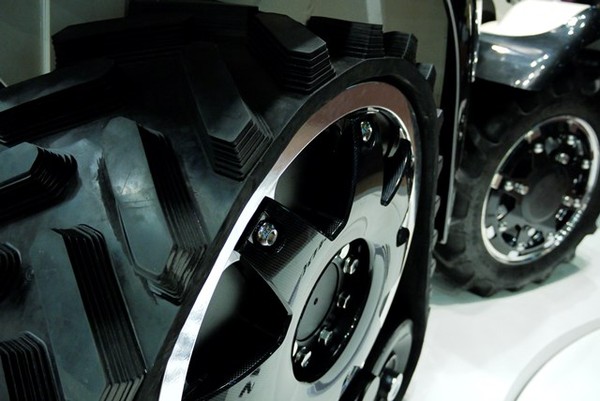
New tracks: rubber + steel for improved transit
Rubber tracks are a significant breakthrough for farm and earth-moving machinery, for they handle difficult terrain and critical conditions more effectively and are now available in a range of specialised designs
In terms of handling critical farming conditions with heavy loads, tracked vehicles have always won hands down against wheeled versions. Yet traditional steel tracks suffer from a number of disadvantages compared to tyres, essentially because of reduced all-round mobility and a large difference in operating comfort.
In recent years, however, a third possibility has been gaining ground: rubber tracks already long used in sectors other than agriculture, above all earth-moving, with which an increasing range of interactions has emerged.
Why steel + rubber
Steel tracks combine great strength with great rigidity, whereas rubber tyres stand out for their elasticity. Rubber tracks enjoy the good aspects of both – and in any case are usually built around a steel core of bunches of cable combining strength with flexibility. There is also a steel-filled section to guide the track over the teeth of the power wheels, and the teeth fit into appropriate slots in the back of the track. The side of the track in contact with the ground has a series of protuberances to give grip, often much like tyre treads.
Machines, large and small
The advantages for general mobility offered by rubber tracks have led to extensive use on tractors at the extreme of the current design range, on some small specialised tractors for orchards and vineyards where a big problem is stability on typically steep terrain, and on very large and powerful models designed to apply great force to machinery working on great widths. In both cases, the advantage of tracks is their significantly larger contact with the ground.
Two or four tracks?
When the first rubber tracks were introduced, designers simply fitted them in place of steel tracks and left the driving and track tension wheels as before. But an increasingly accepted approach, already mooted a few years ago, has been to replace the rear or all the tyres with the same number of rubber tracks, obviously configured differently and smaller than the rubber tracks that simply replaced steel ones.
The advantages include absorbing the terrain’s unevenness better and also improved grip since, unlike traditional tracks with which only the rear axle is a driving axle, each track set provides driving power. But the real superiority of tractors with individual rubber tracks lies in how they interact with the surface soil when turning. While tractors with traditional tracks turn by using the different peripheral velocity of the two tracks, the new rubber tracked designs behave much like tractors with wheels.
Not just tractors
The main gap between wheeled machines and those with traditional tracks has always been their highway performance, especially at a time when machines, especially those used by sub-contractors, have to be moved further. The 15-km/h speed limit was an obstacle that rubber tracks have now eliminated. Tractors and self-propelled machines fitted with rubber tracks can travel at up to 40 km/h in Italy, the top speed for all farm machinery.
A sufficiently safe and comfortable ride is ensured by complex technical developments with sophisticated suspensions and equipment to handle heavy loads, such as for example a high-capacity combined harvester.
One example consists of intermediate rollers made of polyurethane- covered aluminium fitted with hydro-pneumatic suspensions, while the driving wheel and two tension wheels are raised to give a more comfortable ride. The ample radius of the rubber tread’s curves ensure greater resistance and durability. This obtains an optimal situation in the field thanks to ‘floating’ ability, or the ability of the track to minimise pressure on the soil, even when under large loads, and on the highway, when fast, comfortable and safe travel is ensured.
Manufacturers’ solutions
Manufacturers of tractors and self-propelled machinery have offered rubber tracks for some time. Sometimes, they have simply substituted the wheels, or else steel tracks. Only in a very few cases have the machines been designed from scratch, even if using components from existing traditional machinery.
Antonio Carraro’s Mach 4 aroused strong interest when it came out, a derivation from a narrow wheelbase 87 HP tractor with reversible driving seat and same-diameter wheels. These were replaced with four individual, open-profile ribbed tracks similar to normal tyres in configuration. Registered for speeds up to 40 km/h, they guarantee excellent grip even on very rough ground thanks to the tractor’s central joint which permits each individual track a longitudinal oscillation of 8°-11°.
Some manufacturers have installed only two rear tracks. This is the solution offered by the Kubota M8540 Power Krawler and, more recently, BCS’s Sky Jump, a 91 HP narrow gauge tractor with same-diameter wheels, which has DualSteer to give a very small turning circle thanks to a maximum angle of 70°. The two tracks have open-ribbed treads.
The examples given here cover only the most recent models, which also have technical innovations other than rubber tracks. Naturally, their price is rather high, so they are only worth acquiring if they are to be used intensely and continuously.
On the other hand, rubber tracks completely interchangeable with traditional steel ones are available at much more approachable prices. This is the path taken by New Holland’s TK 4000 Smart Trax and, albeit with a different technical solution, by the Smart Trax tracks fitted to the same manufacturer’s combined harvesters. New Holland fits two joined-up tracks with a fish-bone tread, to limit lateral slip in contour work on sloping ground and give highway speed up to the limit, which is 12 km/h in the case of the TK 4000. The manufacturer reports significantly reduced soil compaction and destruction of the grass cover, adding that vibration is also contained compared to a traditional track to less than 0.5 m/s2 which means that a driver can drive all day long without risking a dangerous level of fatigue or, in the long term, vibration-related occupational hazards.








